ACROBAT
Keep your workplace secure with health and safety posters.
Discover how to help your employees and coworkers stay supported and safe.

Promote better working conditions with the proper safety posters.
When safety comes first at work, the job gets done better and faster. Workers feel more at ease and can do their best work because they know their space is secure. If you’re an employer, this type of safe environment for your employees is no doubt among your top priorities.
The five most common workplace health and safety posters.
What signage is most common in your area will depend on where you work — check the specific mandates for your business type and size in your area by using the elaws FirstStep Poster Advisor provided by the US Department of Labor (DOL).
Regardless of region, here are a few of the most common sign types you’ll see:
1. The OSHA “Job Safety and Health: It’s the Law” poster.
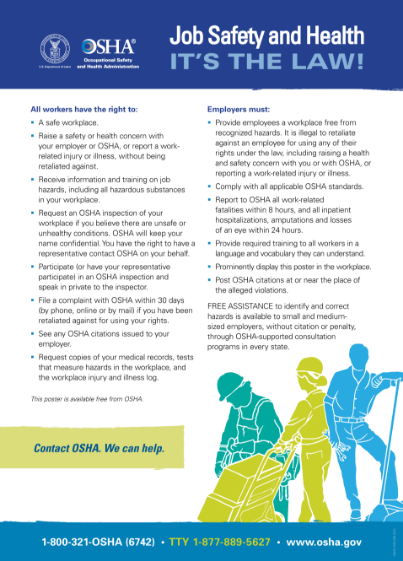
In every state with an Occupational Safety and Health Administration (OSHA) approved state plan, the “Job Safety and Health: It’s the Law” poster is required. This specific Job Safety and Health poster is available to download for free and covers many workers’ rights, including the right to:
- A safe workplace
- Raise a safety or health concern with an employer or OSHA
- Report a work-related injury or illness without being retaliated against
- Receive information and training on job hazards, including all hazardous substances in the workplace
- Request a confidential OSHA inspection of the workplace if the worker believes there are unsafe or unhealthy conditions
- Have a representative contact OSHA on the worker’s behalf
Employers can download and print the poster, or they may request a physical copy from OSHA. Keep a PDF copy of the original poster for safekeeping too.
If you need the poster in another format, say for a PowerPoint presentation, you can convert the PDF to PPT or different file types. Or, if you want to display the poster on a window, you can transform it into a cling film that can be reversed or rotated. Use a tool to rotate PDF file, and then convert it from PDF to JPG — or into another file type ideal for printing.
However you decide to display this poster, make sure it is prominent and accessible to everyone. This may be in the breakroom or common area, but keep remote employees in mind with digital versions. If you’ve only saved the project file as a JPG, make sure to convert it from JPG to PDF before sharing virtually to prevent any edits to this important document.
2. The Fair Labor Standards Act (FLSA) Minimum Wage poster.
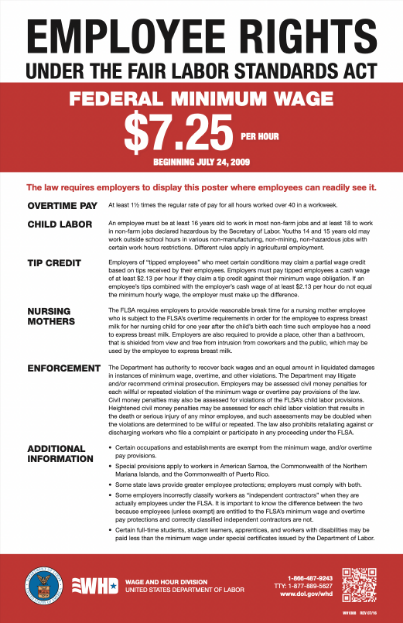
It’s important the employees understand what minimum wage is in their state. The DOL has a minimum wage fact sheet you can post in your workspace. This is required by the FLSA, an act that entitles employees to be aware of the current minimum wage rate. Unlike the OSHA poster, this one needs to be updated when revisions come out. It explains the act and boldly displays the minimum wage.
If you have workers that fall under special provisions for minimum wage, you will also need to display the Employee Rights for Workers with Disabilities/Special Minimum Wage poster. The poster can be downloaded in large, small, color, or black-and-white versions on the DOL website. All files are PDF, so convert as needed.
3. The Employee Polygraph Protection Act (EPPA) poster.
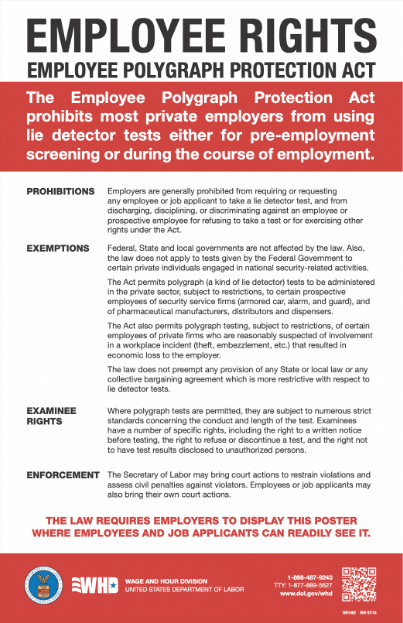
The EPPA bans the use of lie detectors by most private organizations during the hiring process — the EPPA poster states this rule. This not only needs to be visibly displayed to all employees, but it also must be readily accessible to all applicants and candidates for employment.
4. The Uniformed Services Employment and Reemployment Rights Act (USERRA) poster.
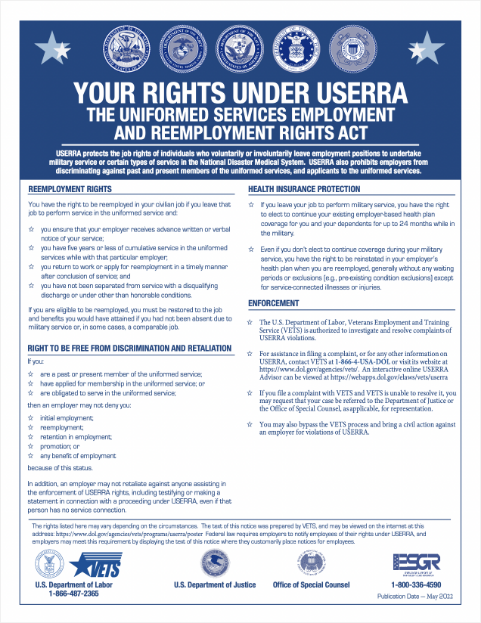
Only required in situations where veterans are entering — or reentering — the workforce, the Uniformed Services Employment and Reemployment Rights Act poster covers veteran employees’ rights concerning:
- Reemployment
- Discrimination
- Retaliation
- Health insurance
- Complaints and enforcement of regulations
The online version is available for distribution to relevant employees as a PDF.
5. The Family and Medical Leave Act (FMLA) poster.
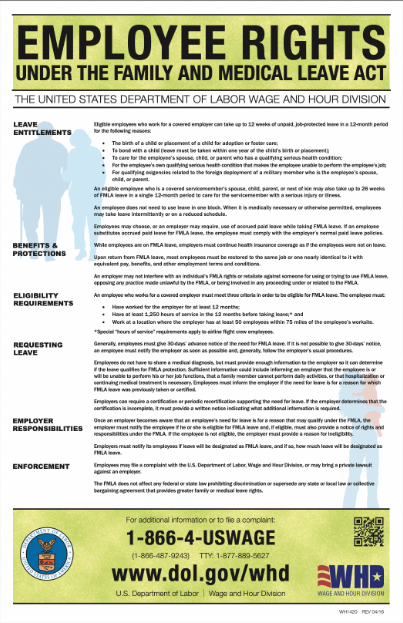
Required for every employer that is covered, the FMLA poster lays out employee coverage for leave in the event of:
- The birth of a child
- The placement of a child for adoption or foster care
- The need to bond with a child (within one year of the child’s birth or placement)
- The need to care for the employee’s spouse, child, or parent who has a qualifying serious health condition
- The employee’s own qualifying serious health condition that makes the employee unable to perform their job
- Qualifying deployment situations of a military member who is the employee’s spouse, child, or parent
The poster details the specifics of taking this sort of leave — including who is eligible and for how long they are covered. Get it as a downloadable PDF and place it in an area where all employees may view it.


Additional health and safety posters that may be required by state or industry.
Depending on your location and industry, you may also need to display:
- Child labor law abstracts
- Hours of work for minors under 18
- Abstract of equal pay laws
- An unemployment compensation fact sheet
- Workers’ compensation insurance posters
- Signs prohibiting smoking per the Indoor Air Quality Act
Find these documents at your state’s DOL site. Keep an eye out for mandatory postings that arise due to specific situations as well, like COVID-19 regulatory postings that were (or may still be) mandatory depending on your location. It’s a good idea for human resources in your organization to sign up for updates regarding this type of compliance.
You can also create and display your own posters. This can include motivational posters, internal processes, and hourly schedules.
How to identify and place safety posters properly
When it comes to identifying and placing your safety posters, choose wisely. More is not always better. As with any other type of communication, you should focus on what’s most important to your audience and then think about when, where, and how to most effectively deliver your message to them.
To properly place a safety poster at your place of employment, follow these instructions:
1. Have a PDF viewer like Adobe Acrobat Reader available on your workstation. Most of the time, posters are only available in PDF format. In order to view and/or print PDF documents, you must click on the link for the poster and wait for it to load into the viewer.
2. Click on the link for the poster and wait for it to load into the viewer.
3. To print, click on the printer icon within Acrobat Reader. Do not use the browser's print feature.
4. Tape or paste the printed pages together to form an 8 x 11 inch or 11 x 17 inch poster that can be displayed effectively at your workstation.

Tips for displaying safety posters effectively.
Health and safety posters are only helpful if people can find and read them, especially when these posters are legally required.
Place safety posters where everyone can see them.
Make sure to consider all of your employees when it comes to poster visibility. Some ideas for proper poster placement include:
- Heavily trafficked doorways
- Hallway corkboards
- Windows in communal spaces
- Breakrooms
- Internal organization software
If the average employee will see the poster daily, it’s in a good spot. If anyone has to ask to see the poster, it needs a better position. And ensure you have backups available regardless — workers have the right to obtain a copy at any time.
Make safety posters legible.
An illegible poster is useless, no matter how prominently placed it is. You may need to have versions translated into different languages, braille versions, or text-to-speech options.
Legibility refers to language too. A DOL-created poster may feature confusing jargon you may need to clarify. Converting the PDF to Word and making a copy is the easiest way to update confusing language without missing key points. Employers can also use a PDF editor to add comments to certain parts of the document for clarification. In any case, the text and images need to be rendered in the highest PDF quality available.
Attach PDF posters to email announcements.
Especially in remote-work environments, online information is the most versatile and accessible. Welcome emails to new employees and employee document portals are a great way to share these posters or update the entire workforce if changes arise.
Explain the details without having to be asked.
Lastly, offer private and group-oriented meetings to discuss the information on posted documents. Some employees may not feel comfortable asking for individualized explanations. To ensure universal understanding, it’s best to preemptively offer clear explanations.
Easy access and the ability to update and share this crucial information is a great way to inform employees. It helps them feel safe and supported, all while efficiently and effectively staying on top of HR compliance.
Discover even more ways Acrobat can help make your life easier.
